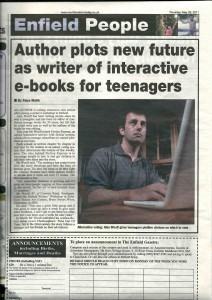Soul Shadows – how it all came about…
My novel Soul Shadows was born out of a collaborative effort with a bunch of teenagers who I never met, but who had a profound influence on the shape of the story. How exactly did this come about? Read on, and discover…
I originally wrote the book for a publisher called Fiction Express. I was approached by Paul Humphreys, the MD, who said he was about to embark on a new, experimental form of publishing in which the readers play a big part in determining how the plot develops. Essentially it works like this: the author writes a chapter a week, and at the end of each chapter the author offers the reader three (occasionally two or four) choices for how the plot should continue. These may be moral choices (should the hero stop and help A or go on with his quest?), intuitive choices (should we trust B or C), dramatic choices (should we attack or flee) and many other kinds. Each reader votes for their preferred option, the votes are totalled up, and the author then writes the next chapter based on the most popular choice. It’s a uniquely democratic way of writing a story, and it places the reader at the very heart of the action.

Fiction Express, the company that first published Soul Shadows, now publish interactive books directly for schools.
I was excited by this experiment and eager to take part in it. The only question was: what story should I write? It so happened that I had recently written a horror short story called Shadow of Death. I showed this to Paul and he thought the idea I’d come up with (in which shadows come to life) would work well for Fiction Express. The story would have to be expanded to eleven chapters of about 5000 words each and it would need to be written for a target audience of teenagers. None of this worried me. I’d written full-length novels for teenagers before and had bags of ideas for how to expand my story. The scariest part of it for me, and also the most exciting, was the interactive aspect – the fact that the readers were going to help steer the plot.
As an author, I’ve always been a loner. I’ve never had any desire to collaborate with other authors. I enjoy the solitude of writing and the complete freedom it gives you to come up with characters, plots and worlds to put them in. So the idea of giving up some of this power to the reader was a challenging one, but also quite exhilarating. Paul said it was important, at the outset, to have a starting point for the novel, as well as a clear idea of how it should end. That way, the author can ensure that things will never get completely out of control. He likened the process to a river flowing down a mountainside. We know where the river starts (a mountain spring) and where it ends (the sea). What we don’t know is the exact course the river will take.
Inspired by this image, I set out to plan the parameters of my novel. I wrote the opening chapter. Then I came up with an approximate idea of the ending – who will survive, who will die, who will win, who will lose, etc. After that, I tried to define the edges of the valley through which my river could flow. In other words, what is permissable within the plot and what isn’t? This would help me determine what choices I could offer readers, and prevent disasters like the hero (or, worse, the monsters) dying in Chapter 2, or the police arriving and fixing everything in Chapter 5.

Soul Shadows is a story about shadows that rise up and kill...
When my opening chapter went live on the Fiction Express website, I felt extremely nervous – but not in the usual way I feel nervous when something of mine is published. Despite all my preparations, I knew that the novel had not been written yet – and that its final form did not even exist in my or anyone’s imagination. I had no idea how or even if it would work as a story. The trouble with writing a story in real time is that there’s no going back. Once a chapter is out there, you can’t snatch it back and rewrite it. If you take a ‘wrong turn’ in the narrative, you have to live with it. If something you wrote in Chapter 4 makes your plans for Chapter 8 impossible, too bad. Such worries plagued me incessantly, and I began to wonder if what I was attempting here was simply beyond my powers. What made things worse were all the positive reviews I was getting for my opening chapter. Readers were excited to see how the story would progress. The pressure was on!
Fortunately, whether by luck or the collective wisdom of my brilliant readers, the process seemed to work. Chapter by chapter the story developed, and I was as surprised as anyone at how smoothly the narrative flowed. I mostly agreed with the choices the readers made, and when I didn’t, the results still seemed to work pretty well.
Perhaps the best example of ‘reader power’ in Soul Shadows came with the introduction of the ‘corpse shadow’ about halfway through the book. I was stuck for a third choice at the end of Chapter 5, and Paul said, ‘hey, you know that dead body in the crypt, why don’t we suggest that it generates a soul shadow?’. The idea that a corpse could sprout a living shadow struck me as too ludicrous for words, but I put it in as a choice because we were running out of time. Of course readers went for it in droves, and a new character, the Rev. Edmund Craven (1841–1898 + 2013), was born – I’d never intended him to be there, but he turned into one of my favourite characters in the entire book!

This article appeared in the local paper while I was writing Soul Shadows.



